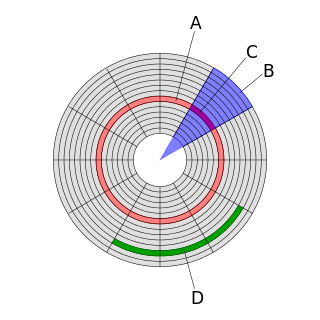Related Research Articles
ReiserFS is a general-purpose, journaling file system initially designed and implemented by a team at Namesys led by Hans Reiser and licensed under GPLv2. Introduced in version 2.4.1 of the Linux kernel, it was the first journaling file system to be included in the standard kernel. ReiserFS was the default file system in Novell's SUSE Linux Enterprise until Novell decided to move to ext3 for future releases on October 12, 2006.
New Technology File System (NTFS) is a proprietary journaling file system developed by Microsoft. Starting with Windows NT 3.1, it is the default file system of the Windows NT family. It superseded File Allocation Table (FAT) as the preferred filesystem on Windows and is supported in Linux and BSD as well. NTFS reading and writing support is provided using a free and open-source kernel implementation known as NTFS3 in Linux and the NTFS-3G driver in BSD. By using the convert command, Windows can convert FAT32/16/12 into NTFS without the need to rewrite all files. NTFS uses several files typically hidden from the user to store metadata about other files stored on the drive which can help improve speed and performance when reading data. Unlike FAT and High Performance File System (HPFS), NTFS supports access control lists (ACLs), filesystem encryption, transparent compression, sparse files and file system journaling. NTFS also supports shadow copy to allow backups of a system while it is running, but the functionality of the shadow copies varies between different versions of Windows.
ext2, or second extended file system, is a file system for the Linux kernel. It was initially designed by French software developer Rémy Card as a replacement for the extended file system (ext). Having been designed according to the same principles as the Berkeley Fast File System from BSD, it was the first commercial-grade filesystem for Linux.
ext3, or third extended filesystem, is a journaled file system that is commonly used by the Linux kernel. It used to be the default file system for many popular Linux distributions. Stephen Tweedie first revealed that he was working on extending ext2 in Journaling the Linux ext2fs Filesystem in a 1998 paper, and later in a February 1999 kernel mailing list posting. The filesystem was merged with the mainline Linux kernel in November 2001 from 2.4.15 onward. Its main advantage over ext2 is journaling, which improves reliability and eliminates the need to check the file system after an unclean shutdown. Its successor is ext4.
Journaled File System (JFS) is a 64-bit journaling file system created by IBM. There are versions for AIX, OS/2, eComStation, ArcaOS and Linux operating systems. The latter is available as free software under the terms of the GNU General Public License (GPL). HP-UX has another, different filesystem named JFS that is actually an OEM version of Veritas Software's VxFS.
The Unix file system (UFS) is a family of file systems supported by many Unix and Unix-like operating systems. It is a distant descendant of the original filesystem used by Version 7 Unix.
In computing, a block, sometimes called a physical record, is a sequence of bytes or bits, usually containing some whole number of records, having a maximum length; a block size. Data thus structured are said to be blocked. The process of putting data into blocks is called blocking, while deblocking is the process of extracting data from blocks. Blocked data is normally stored in a data buffer, and read or written a whole block at a time. Blocking reduces the overhead and speeds up the handling of the data stream. For some devices, such as magnetic tape and CKD disk devices, blocking reduces the amount of external storage required for the data. Blocking is almost universally employed when storing data to 9-track magnetic tape, NAND flash memory, and rotating media such as floppy disks, hard disks, and optical discs.

In the maintenance of file systems, defragmentation is a process that reduces the degree of fragmentation. It does this by physically organizing the contents of the mass storage device used to store files into the smallest number of contiguous regions. It also attempts to create larger regions of free space using compaction to impede the return of fragmentation. Some defragmentation utilities try to keep smaller files within a single directory together, as they are often accessed in sequence.
Reiser4 is a computer file system, successor to the ReiserFS file system, developed from scratch by Namesys and sponsored by DARPA as well as Linspire. Reiser4 was named after its former lead developer Hans Reiser. As of 2021, the Reiser4 patch set is still being maintained, but according to Phoronix, it is unlikely to be merged into mainline Linux without corporate backing.

df is a standard Unix command used to display the amount of available disk space for file systems on which the invoking user has appropriate read access. df is typically implemented using the statfs or statvfs system calls.

In computing, a file system or filesystem governs file organization and access. A local file system is a capability of an operating system that services the applications running on the same computer. A distributed file system is a protocol that provides file access between networked computers.
File size is a measure of how much data a computer file contains or, alternately, how much storage it consumes. Typically, file size is expressed in units of measurement based on the byte. By convention, file size units use either a metric prefix or a binary prefix.
Extended file attributes are file system features that enable users to associate computer files with metadata not interpreted by the filesystem, whereas regular attributes have a purpose strictly defined by the filesystem. Unlike forks, which can usually be as large as the maximum file size, extended attributes are usually limited in size to a value significantly smaller than the maximum file size. Typical uses include storing the author of a document, the character encoding of a plain-text document, or a checksum, cryptographic hash or digital certificate, and discretionary access control information.
In computer storage, fragmentation is a phenomenon in which storage space, main storage or secondary storage, is used inefficiently, reducing capacity or performance and often both. The exact consequences of fragmentation depend on the specific system of storage allocation in use and the particular form of fragmentation. In many cases, fragmentation leads to storage space being "wasted", and in that case the term also refers to the wasted space itself.
The following tables compare general and technical information for a number of file systems.

In computer disk storage, a sector is a subdivision of a track on a magnetic disk or optical disc. For most disks, each sector stores a fixed amount of user-accessible data, traditionally 512 bytes for hard disk drives (HDDs) and 2048 bytes for CD-ROMs and DVD-ROMs. Newer HDDs and SSDs use 4096-byte (4 KiB) sectors, which are known as the Advanced Format (AF).
A page, memory page, or virtual page is a fixed-length contiguous block of virtual memory, described by a single entry in a page table. It is the smallest unit of data for memory management in an operating system that uses virtual memory. Similarly, a page frame is the smallest fixed-length contiguous block of physical memory into which memory pages are mapped by the operating system.
Free-space bitmaps are one method used to track allocated sectors by some file systems. While the most simplistic design is highly inefficient, advanced or hybrid implementations of free-space bitmaps are used by some modern file systems.
The FAT file system is a file system used on MS-DOS and Windows 9x family of operating systems. It continues to be used on mobile devices and embedded systems, and thus is a well suited file system for data exchange between computers and devices of almost any type and age from 1981 through the present.
EROFS is a lightweight read-only file system initially developed by Huawei, originally for the Linux kernel and now maintained by an open-source community from all over the world.
References
- ↑ U.S. patent 6,041,407 (Fundamental patent.)
- ↑ Hans Reiser (2001). "Hard Disk usage, ReiserFS and Ext2fs". Archived from the original on 13 November 2006. Retrieved 14 December 2006.
- ↑ Hans Reiser (2001). "ReiserFS file system design". Archived from the original on 13 November 2006. Retrieved 14 December 2006.
- ↑ Hervey, Allen (20 June 2005). "Introduction to FreeBSD, PacNOG I Workshop, Additional Topics, UFS2 and Soft Updates make for a powerful combination" (PDF). PacNOG I. p. 23. Retrieved 22 July 2012.
- Daniel Robbins (1 August 2001). "Advanced filesystem implementor's guide, Part 2". Common threads, IBM . Retrieved 14 December 2006.